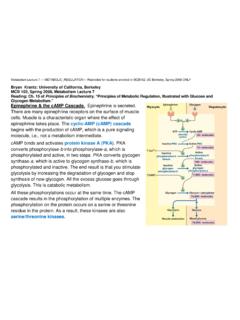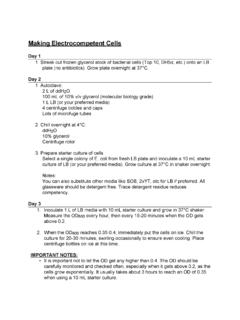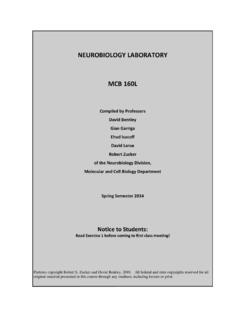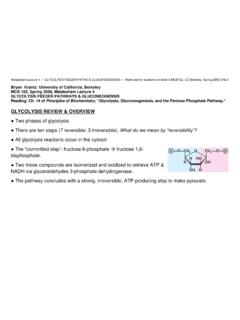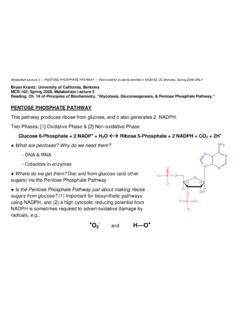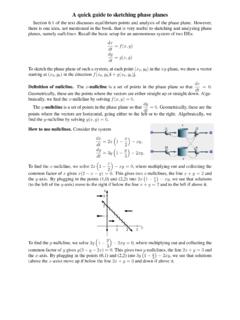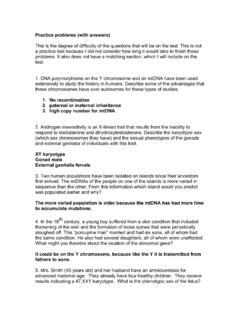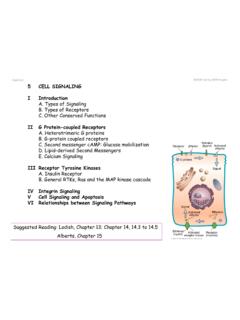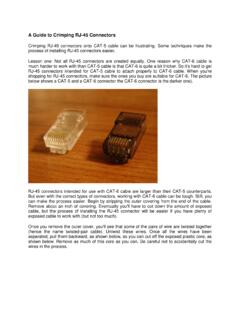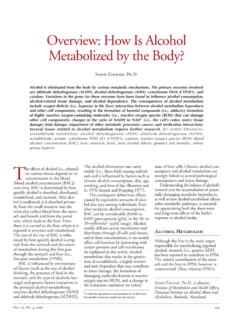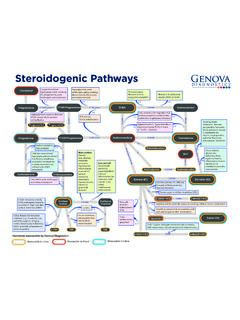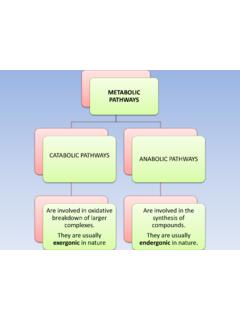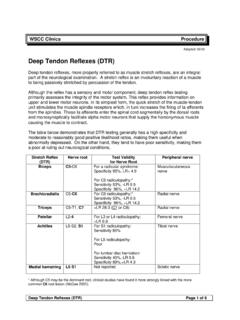Transcription of cyclic-AMP (cAMP) cascade protein kinase A (PKA). PKA
1 Metabolism Lecture 7 METABOLIC_REGULATION Restricted for students enrolled in MCB102, UC Berkeley, Spring 2008 ONLY Bryan Krantz: University of California, Berkeley MCB 102, Spring 2008, Metabolism Lecture 7 Reading: Ch. 15 of Principles of Biochemistry, Principles of metabolic Regulation, Illustrated with Glucose and Glycogen Metabolism. Epinephrine & the cAMP cascade . Epinephrine is secreted. There are many epinephrine receptors on the surface of muscle cells. Muscle is a characteristic organ where the effect of epinephrine takes place.
2 The cyclic-AMP (cAMP) cascade begins with the production of cAMP, which is a pure signaling molecule, , not a metabolism intermediate. cAMP binds and activates protein kinase A (PKA). PKA converts phosphorylase-b into phosphorylase-a, which is phosphorylated and active, in two steps. PKA converts glycogen synthase-a, which is active to glycogen synthase-b, which is phosphorylated and inactive. The end result is that you stimulate glycolysis by increasing the degradation of glycogen and stop synthesis of new glycogen.
3 All the excess glucose goes through glycolysis. This is catabolic metabolism. All these phosphorylations occur at the same time. The cAMP cascade results in the phosphorylation of multiple enzymes. The phosphorylation on the protein occurs on a serine or threonine residue in the protein . As a result, these kinases are also serine/threonine kinases. Metabolism Lecture 7 METABOLIC_REGULATION Restricted for students enrolled in MCB102, UC Berkeley, Spring 2008 ONLY Amplification. You do this in many steps to amplify the effect.
4 You come in with one signal molecule of epinephrine, which will activate the receptor. The receptor will activate many G-proteins. Each of these G-proteins will activate adenylylate cyclase. cAMP will activate many PKA enzymes. At every step, there will be many-fold amplification. One single hormone molecule activate hundreds of phosphorylations Unlike allosteric regulation, you produce a permanent change in the enzyme molecule, so the effect can be lasting. Reciprocal Regulation. The reversal of the enzyme phosphorylation modification may require either a kinase or a phosphatase enzyme and these are regulated in a reciprocal fashion.
5 Metabolism Lecture 7 METABOLIC_REGULATION Restricted for students enrolled in MCB102, UC Berkeley, Spring 2008 ONLY Regulation of Glucose Homeostasis under Normal Conditions Regulation vs. Control. These are two terms for specific situations. metabolic regulation maintaining [metabolite]; homeostasis. metabolic control in response to stimulus the output through the metabolic pathway is altered Fight or Flight . Brain senses danger; muscles prepare to run. Hypoglycemia. What happens when the blood sugar is too low?
6 Mental impairment, impaired judgement, nonspecific dysphoria, anxiety, moodiness, depression, crying, negativism, irritability, belligerence, combativeness, rage, personality change, emotional lability, fatigue, weakness, apathy, lethargy, daydreaming, sleep, confusion, amnesia, dizziness, delirium, headaches, seizures, and eventually coma. The brain is very affected; and this is very bad. Diabetes. What happens when the blood glucose level is too high? Recall C1 of glucose is an aldehyde. It is a reactive and produces an addition compound with proteins; glucose adducts of hemoglobin that can be quantified in a laboratory test.
7 Obviously glucose-modified proteins are not a good thing and diseases, which cannot regulate [glucose] in the blood can be harmful if not managed. To assess whether there is diabetes, a doctor can test for the amount of glucose after fasting. Doctors also want to know what the average level of glucose is in your blood stream while you are carrying on daily chores. The amount of glucose-modified hemoglobin is a very good indicator. Homeostasis of Blood [Glucose]. Goldy Locks says, The glucose concentration is just right!
8 Glucose levels should be in the range of ~4 to 8 mM. Metabolism Lecture 7 METABOLIC_REGULATION Restricted for students enrolled in MCB102, UC Berkeley, Spring 2008 ONLY Glucagon. Low blood glucose levels can also be catastrophic, because your brain can only really utilize only glucose. (It can utilize ketone bodies in a crisis.) The brain requires a constant supply of glucose, else it will stop functioning and confusion will set in. The pancreas senses low blood glucose levels and releases glucagon, a polypeptide hormone, into the blood.
9 Glucagon mostly affects the liver because liver cells have a large number of glucagon receptors. By changing the number of receptors, you can produce organ-specific regulation. Glucagon receptor cAMP cascade Phosphorylation reactions Glycogen breakdown Glycogen via phosphorylase Glucose 1-phosphate Glucose 6- phosphate For muscle, the glucose-6-phosphate goes into glycolysis and will generate energy. For liver, the degradation of glucose-6-phosphate through the glycolytic pathway is inhibited. Glucose 6-phosphate accumulates.
10 The liver hydrolyzes glucose-6-phosphate into free glucose, which is then released into the bloodstream for other organs, like the brain. Metabolism Lecture 7 METABOLIC_REGULATION Restricted for students enrolled in MCB102, UC Berkeley, Spring 2008 ONLY Glycolysis Regulation. How does glycolysis become inhibited? By the cAMP cascade , many enzymes get phosphorylated, including a liver enzyme that makes yet another signaling molecule, called Fructose 2,6-bisphosphate. This is a signaling molecule, unique from fructose 1,6-bisphosphate a direct metabolite of glycolysis and gluconeogenesis.
